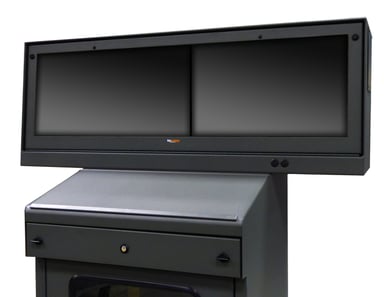When planning for a computer enclosure deployment in a manufacturing setting, there are several things to consider and patiently research.
The following 6 tips will help system integrators plan for a successful computer enclosure deployment:
1. What is the big picture?
At the beginning, meet with all team members that will be involved in the project, including engineering, IT, and production. Understand the problems or challenges that may arise and review the costs and time constraints that exist for the project. Evaluate the hardware required and include implementation issues like ergonomics, navigation, and accessibility. Ask questions and take notes.
2. Perform a plant review
Conduct a design review, with plant personnel, to discuss any concerns that they may have with the solution. For example, to print product labels, bar code printers are extremely popular for use on a plant or manufacturing floor. It is advantageous to install a printer inside of an enclosure to protect it from heat, dust, dirt, and other airborne contaminants. Consider all challenges and plan accordingly. No company should require an operator to continually bend over to retrieve labels. In this instance, it would behoove a company to find a pedestal or floor standing model to alleviate this issue. Listen to the feedback from employees and develop a user-friendly enclosure solution.
 3. Standardize the equipment
3. Standardize the equipment
When possible, standardize the equipment that you plan on using at every workstation throughout the facility. Do not make the mistake of choosing different HMIs for various stations. If an enclosure manufacturer is required to make multiple panel mount doors and assorted sizes and shapes of cutouts, this will create unnecessary custom fees. In addition, it will be easier on the production operators, because they will be familiar with all the hardware throughout the plant, thus eliminating a large learning curve. Develop your own stringent standards to streamline the process.
4. Determine the location
One of the most frequently asked questions an enclosure specialist will inquire: “What type of environment will the PC enclosure be installed?” This is vital in determining the necessary NEMA rating. Understand the primary contaminants the cabinet needs to protect against – dust, splashing fluids, wash-down, corrosive materials, etc… Considerations for heating and cooling are also essential in creating the best overall solution. Air conditioners or heaters could be easy to install and keep electronics at an optimal temperature.
5. Build a prototype
In larger deployments, it is imperative that manufacturers build a prototype to ensure that they are ordering the right solution. Be wary of enclosure manufacturers that do not encourage this step. A quick sale - without thorough investigation - may result in the wrong solution. End users should be able to evaluate the solution prior to committing capital funds. Upon receipt of the prototype, the team will be able to determine quickly if the solution will work for everyone’s needs and verify the overall user friendliness. For solutions that are not completely custom, cabinet suppliers may offer an evaluation unit for a period of 30 days.
6. Evaluate enclosure support
On individual websites, many enclosure companies claim to be good, reputable businesses. However, sometimes actions speak louder than words. It is unfortunate that you do not know you purchased a “not so great” solution until a problem occurs. When support is required, the 'ever so helpful' sales person (that was so eager to earn your business), is nowhere to be found. From day one, do your homework and ask the right questions. Research how long the company has been in business, who they have worked with in the past, the warranties that are offered, and ask about the accessory replacement policy. Overall, the better technical support that is offered will increase the likeliness of a successful project.
Computer enclosures will save time and money over the course of many years. If computers, printers, or monitors are exposed to harmful elements, they will probably fail in a short period of time. Security and shielding are the key. NEMA rated, heavy-duty enclosures will protect electronics and keep a computer system running smoothly. Never settle for a cheap, flimsy, mediocre product just to save a few dollars. With the proper exploration, a computer enclosure can be the protection that is necessary for any electronics to stay clean and dry.
For More Information:
-- 8 Keys for Selecting the Proper PC Enclosure
-- What Makes IceStation Industrial Enclosures Stand Out from the Crowd?
-- Determining the Value in Computer Enclosures
HAVE QUESTIONS? LET US KNOW HOW WE CAN BEST ASSIST YOU!
CONTACT AN 'ITSENCLOSURES EXPERT' AT 1-800-423-9911 -OR- SEND US AN EMAIL: INFO@ITSENCLOSURES.COM



